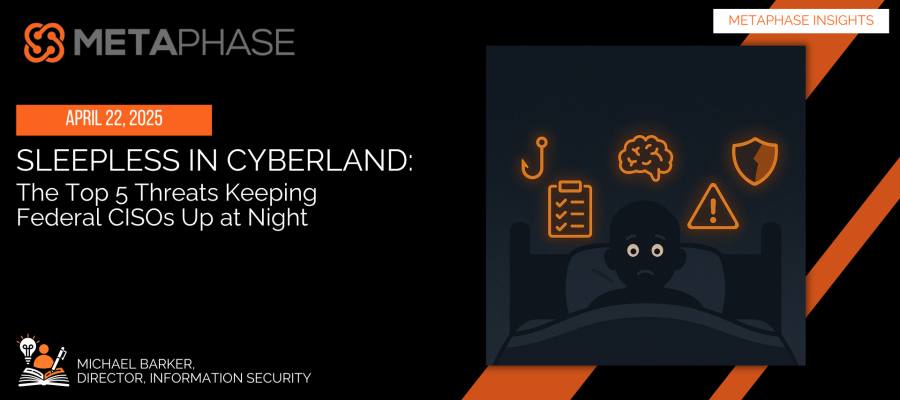
“It’s not paranoia if they’re really out to get you.” This adage feels especially true for Federal CISOs navigating an unrelenting storm of cyber threats, compliance mandates, and budget constraints.
Every night, federal CISOs (Chief Information Security Officers) lie awake worrying about the same core dilemma: how to secure increasingly complex IT environments while enabling mission execution. The challenge is only growing. From AI-powered threats to insider risk, the modern CISO’s job is a delicate high-wire act between innovation and resilience. Here are the top five things that are robbing sleep from the people tasked with protecting our nation’s most critical systems.
1. Weaponized AI & Next-Gen Threats
Artificial intelligence isn’t just a tool for good—it’s now in the hands of threat actors. Deepfake phishing attacks, generative AI that mimics writing styles, and automated vulnerability scanning powered by machine learning are raising the stakes. These AI-enabled attacks move faster than traditional defenses can react, leaving CISOs to rethink their entire security playbook. Agencies that fail to build AI-awareness into their threat models risk falling behind attackers who’ve already automated their kill chains.
2. Legacy Systems + Zero Trust = Cognitive Dissonance
Zero Trust isn’t just a framework—it’s a mindset. But that mindset clashes with the reality of aging legacy systems that still rely on perimeter-based security. The Office of Management and Budget (OMB) has made Zero Trust a government-wide priority, yet many agencies struggle to retrofit outdated infrastructure with modern identity, device, and network segmentation protocols. The result? CISOs are stuck mediating between transformation and technical debt, trying to secure systems never designed to be internet-facing in the first place.
3. Continuous Compliance in a World of Continuous Change
The speed of threat evolution is outpacing the traditional Authority to Operate (ATO) process. While frameworks like Continuous ATO (cATO) offer promise by embedding automated compliance checks into DevSecOps pipelines, adoption remains uneven. Without real-time visibility and automated monitoring, CISOs remain tethered to static security postures that can’t keep pace with dynamic environments.
4. Insider Risk and the Human Attack Surface
As agencies adopt hybrid work, remote access, and cloud collaboration tools, the human element becomes both the weakest link and the largest attack surface. From negligent insiders clicking on phishing emails to malicious actors with elevated privileges, insider risk management has become a top-tier concern. Behavioral analytics and real-time monitoring offer hope—but not without privacy trade-offs and cultural resistance.
5. Supply Chain Vulnerabilities and the Blind Spots They Bring
The SolarWinds breach was a wake-up call. Today’s cyber threats often enter through the back door—via third-party software, shared APIs, or insecure cloud providers. CISOs are expected to vet and monitor a sprawling ecosystem of vendors, contractors, and services, many of which fall outside traditional perimeter defenses. Without full visibility into their digital supply chain, agencies can’t defend what they can’t see.
Federal CISOs don’t need more alerts—they need solutions that reduce risk, automate trust, and enable mission agility. The way forward requires federal leaders to invest not only in new tools but also in cultural transformation: Zero Trust mindsets, continuous compliance, and proactive AI governance.
MetaPhase’s Role
MetaPhase is at the forefront of federal cybersecurity modernization. Our OrangeArmor accelerator embeds security from day one—enabling Start-Left practices that integrate risk management into the entire system lifecycle. Our support for Continuous ATO automates compliance while maintaining mission speed. And with Mpower, we’re helping agencies securely integrate GenAI into operations while managing risk in real-time.
We don’t just deliver tools—we deliver cyber resilience designed for the realities of government IT.

